So earlier this week I was in Sault Ste. Marie again with a friend of mine to ride the full Tour of the Line from Sault Ste. Marie to Hearst.
First thing in the morning we went down to the station to pick up our reserved tickets and watched it depart and picked up our reserved tickets. My friend had booked a little earlier and was riding the Agawa Canyon Tour Train to Canyon and then getting on the Tour of the Line on a “Canyon Combo” package, allowing the tour of the line and also a short stopover at Canyon park. I booked a little later and the Canyon train was fully sold out, but ultimately this probably turned out for the best as shooting from the vestibules is not permitted on the Canyon train. The regular train to Hearst has a far more relaxed attitude. We definitely spent more time shooting out the vestibule window or the rear door of the coach than actually sitting in our seats.
The Canyon train was absolutely running at full capacity, so I finally got to fill in the missing names on my roster of the ex-“Ski Train” cars as every single one of them was in use on the train.
CN 633 Full consist northbound on Sept. 30, 2013:
CN 105 (F40PH)
CN 104 (F40PH)
AC 5700 “Achigan Lake”
AC 5701 “Montreal River”
AC 5710 “Agawa River”
AC 5705 “Spruce Lake”
AC 5702 “Lake Superior”
AC 5655
AC 5703 “Chippewa River”
AC 506 (Diner)
AC 5707 “Hubert Lake”
AC 5708 “Ogidaki Lake”
AC 5704 “Island Lake”
AC 5706 “Batchewana River”
AC 5709 “Mongoose Lake”
AC 5711 “Trout Lake”
AC 5712 “Goulais River”
AC 5713 “Rand Lake”
CN 106 (F40PH)
(3 engines, 16 cars)
After the Canyon train pulled out of town it was time to head over to the yard to catch my train. For the last couple of years now the regular train to Hearst has been boarding from the near the shops facilities rather than the passenger depot downtown. With all three of the F40PHs assigned to the Canyon train, the regular train to Hearst this week was powered by a CN GP38-2.
CN 631:
CN 4710 (GP38-2)
AC 78 (Power Car)
AC 312 (Baggage Car)
AC 5656 (Coach)
We hit patches of thick morning mist around the Heyden to Searchmont area, but otherwise the weather was generally clear, and the temperature quite pleasant:
At Northland, we pulled into the siding to allow the southbound freight to pass:
CN 574:
CN 2575 (C44-9W)
CN 2136 (C40-8W)
(25 cars – several coil steel cars and a bunch of empty gondolas)
At Ogidaki we dropped off a group heading to their cabin for a few weeks; this was pretty much our only northbound stop before Canyon. Much of the south end of the line skirts along a multitude of lakes and rivers, and many of these lakes are dotted with small private camps and cabins, accessible only by rail (and additionally in many cases, by boat across the lake from the railway stop.)
Of course a highlight of any trip on the ACR is crossing the famed trestle at Montreal Falls, made all the more spectacular by the peak fall colours:
At Canyon we passed the tour train, dropped off a young honeymooning couple who were going to be staying at the Camp Car which was set out in the house track and picked up half a dozen passengers (including my friend) riding on the “Canyon Combo” package.
After leaving the park at Canyon, it was a straight shot to Hawk Junction. As we pulled through Hawk, train 573, which had preceded the passenger trains out of Sault Ste. Marie (Steelton), was switching two full tracks of cars in the yard. Quite a bit more traffic than I saw in my July visit. A lot of these cars would be noticed the next day in the interchange tracks at Oba. (Those three gondolas being pushed by the power were the only cars in Hawk Junction yard the next day.)
CN 573:
CN 2562 (C44-9W)
CN 5631 (SD75i)
(no accurate car count as this train was actively engaged in switching, and there were long strings of cars on at least two tracks)
At Hawk Junction we boarded another small group and their supplies who travelled as far as Tatnall to a camp. That was our last stop northbound before Hearst. The CP and CN main lines at Franz and Oba were crossed without delay from cross traffic on the other lines. At Mosher, the old station and some signs of the abandoned pulpwood operations still remained:
We arrived at Hearst just after 8 pm, which made it well after dark with the shortening fall days. Tired and hungry (but having enjoyed the ride) we sought out our hotel and some dinner before preparing to do the whole thing in reverse.
I ended up taking at least 900 photos during the trip, so there’s far too much material to share here in one blog posting (and a lot of the photos are somewhat similar, but serve as some future modeling reference for some areas. I’m going to split the second day’s southbound trip into a separate post, and I may have enough material to organize into some additional related posts over the next week or so. I’ve tossed about about a dozen new header images into the random page header rotation.
For now I’ll pause to make some general observations from the trip:
- Our timing worked out brilliantly. We were lucky enough to hit the absolute peak of the fall colour season in the Sault. A week earlier wouldn’t have been quite so colourful, and we could see that some trees particular on the tops of some hills and ridges were already dropping their leaves. Another week later and a lot of the colour would already be disappearing. We also lucked out with some beautiful weather the whole time. (It was a little overcast on the second day between Canyon and the Sault, but was otherwise mostly sunny and the temperatures were very comfortable.
- About those colours: the south end of the line was brilliant with almost every colour of red, orange and yellow imaginable. The maple trees were bright, bright red. As the geography transitioned to the flatlands north of the canyon, the scenery became predominated by birch and evergreen trees, so the north end of the line was basically just two colours: yellow and dark green. This is an important observation to make for when I’m working on scenery on my future ACR layout. Getting that type of tree mix right will be a huge factor in pulling off the right effect.
- There was a fair bit of interchange traffic at Franz, Oba and Hearst, but on-line industry north of the Sault is essentially nil today. The sawmill at Dubreilville appeared inactive, and while the Jaeger strandboard plant south of Hawk Junction could not actually be seen from the main track, IIRC it closed down about 5 years ago or more.
- (Quite) active log spurs at approx. mile 10, Eton (mile 120) – pictured above – and the siding at Langdon, just south of Oba, basically comprise the actual on-line traffic sources on the former ACR. Other sidings on the south end such as Batchewana, Mekatina and Frater and other places have been known to feature log loading operations in the past but these all appeared to be quite inactive for some time. There were also spurs at mile 132 and 155 that were still in place, but didn’t appear to be currently active. Still the above mentioned log spurs were significant current operations, and there did seem to be a fair bit of interchange traffic at Franz and Oba.
- I’d been led to believe a few years ago that freight traffic over the former ACR had been reduced to only a three times a week service and that track conditions on the line had suffered to the point where almost the entire line was severely speed restricted. I wouldn’t have thought traffic levels to have actually improved since then, but today freight trains definitely are operating in both directions on a daily basis over the ACR, at least south of Hawk Junction. While there were slow spots here and there, over the majority of the line we regularly hit speeds of 40-45 miles per hour, very similar to what the old speed limits in ACR timetables were. While I’m certainly no track maintenance worker or a qualified expert on such things, the ROW generally appeared in decent shape, although I did notice some pretty horrifically shelled rail on at least one siding; however many old sidings have been removed or single-ended, and particularly on the north end of the line are pretty rare. The particular siding(s) in question probably hasn’t been used to actually execute a train meet in a decade. The only freights we passed on both days were south of Hawk Junction. There’s definitely a lot of jointed rail, but significant sections have actually been upgraded with CWR.
- The meets our train made with opposing freight trains were handled by the passenger train either pulling into one end of the siding, waiting for the freight to pass, and then backing out again, or the reverse: backing into a siding to make the meet and then pulling out normally. Dispatching-wise this was accomplished by giving all the passenger trains “work” clearances, which allow a train to operate in either direction over a section of track, and the opposing trains were given “protect against” orders referencing the passenger train. Thus the two trains would actually set their own meet over the radio somewhere within that stretch of track.
- Several maintenance foremen were also patrolling the tracks, and once or twice we were delayed waiting for highrail trucks to pull into a siding to clear our train.
I think that’s enough for now, we’ll continue with the southbound trip in Part 2.


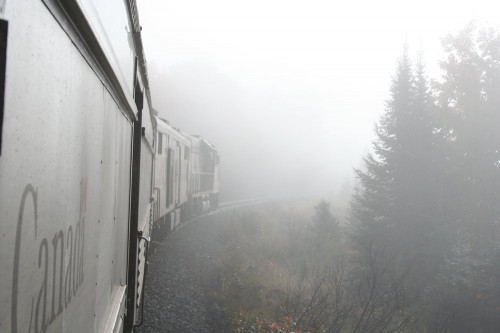

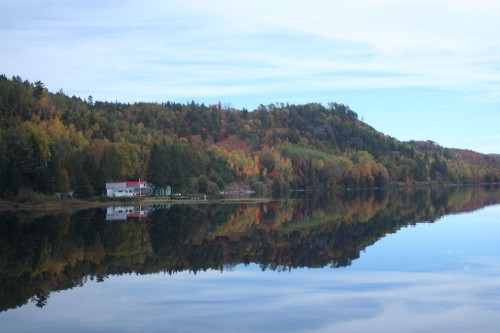


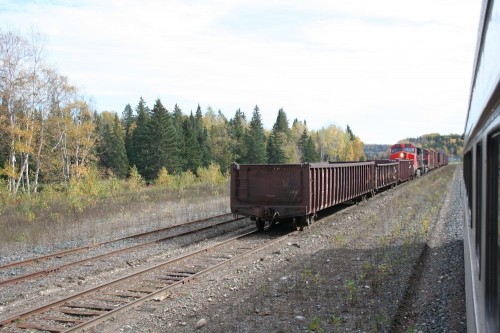
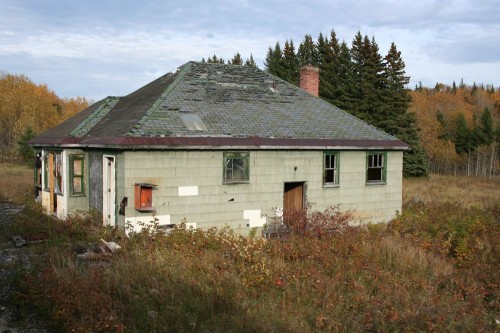
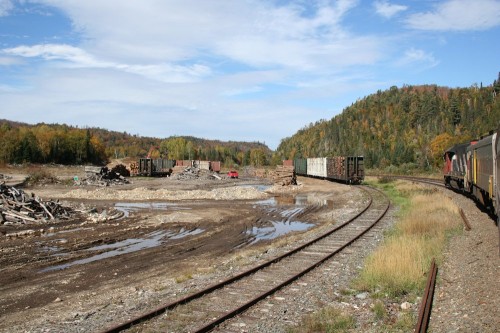
Very good pics, and descriptions… Always happy to see things like this, as I’m about 400 miles from the ACR…